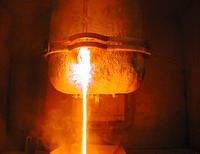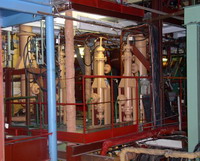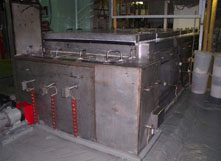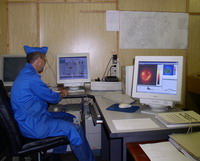Vitrification of RW
 The RW vitrification technique makes it possible to achieve the best quality indicators of matrices and their stability to the effects of the environment. RADON has an extensive experience of activities in vitrification of low- and medium-level waste. At present time, this technique makes it possible to process a broad spectrum of liquid and solid RW with production of vitro-crystalline and glass-like materials.
The RW vitrification technique makes it possible to achieve the best quality indicators of matrices and their stability to the effects of the environment. RADON has an extensive experience of activities in vitrification of low- and medium-level waste. At present time, this technique makes it possible to process a broad spectrum of liquid and solid RW with production of vitro-crystalline and glass-like materials.
The research undertaken by RADON experts have shown that the most efficient technique is the inductive melting technique using a smelter of the Cold Crucible type. Its advantages include low cost, high specific productivity, adaptability to manufacture and maintainability, which is very important for the RW handling. The use of this smelter makes it possible to achieve working temperatures of over 1650°C, and this process has low inertia.
An advantage of the technology developed at RADON is also that it does not require the use of expensive materials in short supply for the burden preparation and use of high pressures, while the end product may be obtained as castings of any shape.
LRW vitrification unit
The liquid radioactive waste (LRW) vitrification unit is intended for the low- and medium-level LRW solidification in a cold-crucible inductive smelter (CCIS). Low- and high-salt LRW is processed. The unit enables evaporation of LRW and production of glass-like materials fit for long-term storage.
Pilot plant.
Has been in operation since 1999 for scheduled processing of LRW. The unit was used to study the possibility of using the CCIS technology and the unit’s main components for processing RW of different compositions. It is also possible to use the technology for processing a broad spectrum of radioactive, industrial and domestic waste with production of various materials including:
-glass-like materials based on ash, spent ion-exchange resins and catalysts;
-crystalline materials of the Synrock or basalt type;
- enamels.
The unit can be used at the NFC enterprises for solidifying medium-level LRW.
Технические характеристики:
|
Capacity with the initial LRW salt content of 20 g/l |
up to 500 l/h 50 85 up to 25 kg/h 3 160 kW 1.76 MHz 3/h 1150 -1250 оС 3,7*107 Bq/kg 3,7*106 Bq/kg |
|
|
|
|



















